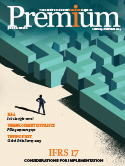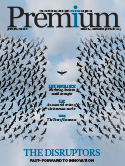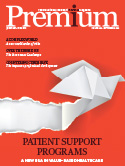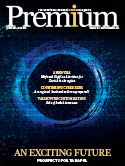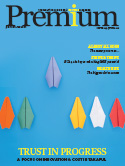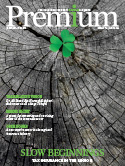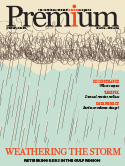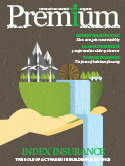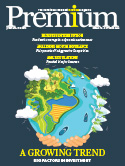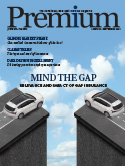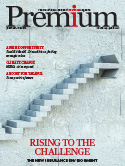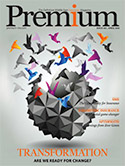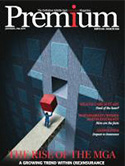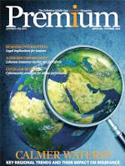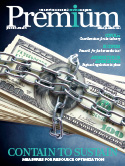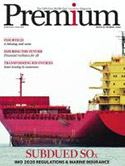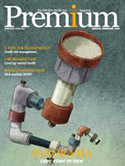Surviving in the New Market

In the face of new regulations, a pandemic, and the influx of technological push by insurers, how is the aggregator surviving? Sandhya Divakaran speaks to a few players in the market.
In April 2021, the region marked one year after the lockdown and the extenuating circumstances that made it difficult to work, socialize, travel and do all the things that we do as social human beings. The pandemic has changed life so irreversibly that it will take a long time before many parts of the world begin to go back to the way things were.
The GCC and the wider Middle East region is continuing with adequate precautions to ensure that the number of cases reduce and the burden on the healthcare infrastructure is not too much that it puts a dent in the overall economy. While many industries have taken a hit, insurance seems to be pulling its weight quite nicely.
In fact, it is fair to say that many companies within the insurance industry were already in the midst of transitioning to cater to millennials, online segments and more. Following numerous regulations and instructions from the Insurance Authority, now part of the Central Bank within the UAE, many companies within the insurance industry have had to change the way they do business. A good example is that of the insurance price comparison websites or aggregators who were subject to a new set of regulations that seem to have caused perplexity within some quarters and further due diligence and new ways of working for others. The new regulation – no. 18 of 2020, Concerning the Electronic Insurance Regulations, specifically mentions price comparison websites or aggregators in Article 15, where brokers are not obliged to do business with websites that are not registered with the Insurance Authority. This is quite a paradox as only two websites have been registered since many years with the regulator. The new regulation also specifically restricts aggregators from engaging in any other activity other than price comparison. More importantly, aggregators will not be allowed to maintain, store, or copy and electronic data or information related to potential clients or clients and such information will have to be sent to the broker electronically.
Given this new way of working, many companies have chosen to circumvent this ‘complication’ by setting up their own brokerage licence, and some brokers decided to set up their own price comparison websites. “We, at Yallacompare, took the decision to acquire an existing brokerage licence to allow us to bring everything inhouse. Whilst the new regulations have caused

Jonathan Rawling, CFO, Yallacompare
us to change significantly, we believe that it makes absolute sense to effectively require aggregators to become brokers and be subject to all the compliance and regulatory requirements that such a move brings. When we first approached the Insurance Authority, they were quick to point out that we had previously not been regulated but made it clear that they would be delighted to welcome us as a broker in our own right,” said Jonathan Rawling, CFO, Yallacompare. The company recently acquired Gulf Resources Insurance Management to continue to operate effectively within the UAE.

Avinash Babur, founder and CEO, insurancemarket.ae
Insurancemarket.ae is another website that is attached to an insurance broker, namely AFIA Insurance Brokerage Services. Avinash Babur, founder and CEO of the aggregator welcomes the new initiative because “they take consumer and insurer protection one step further and ensure that there are no unscrupulous providers selling regulated products under the guise of being tech companies.”

Neeraj Gupta, CEO, Policybazaar UAE
Some companies believe this will ultimately aid the consumer and his or her choices. “With new regulations by the Central Bank of UAE the regulator has tried to bring more transparency on the product and the charges applicable to them. This will be a good confidence booster for consumers. With very low penetration on life insurance in the UAE, building transparency will help the overall industry. Also, this will lead to the creation of better products for people in the region,” noted Neeraj Gupta, CEO of Policybazaar UAE.
Indeed, this move is a harbinger of transparency which will open the market so to speak, while focusing on the consumer. For some aggregators, the association with the right broker will make all the difference, as the broker is the element in the chain that can interact with potential clients, advise them of other products and receive premiums while the aggregator is paid a lumpsum amount.
In other GCC countries such as the Kingdom of Saudi Arabia (KSA) and Bahrain, the regulations meant for aggregators have been designed with clearer instructions, such as minimum capital amounts for the aggregator and their partnering broker, a pilot of all web transactions and IT infrastructure, including validation procedures of policies, a choice between takaful and conventional, data encryption requirements, complaints procedures and so on.
Since the regulatory push towards supervision of aggregators began in the region in 2019, an interesting point has been the changing attitudes of insurance companies towards their association with aggregators, especially since many of them were in the midst of setting up their online operations. From a completely negative standpoint, many insurance companies,

Walid Daniel Dib, CEO, hala
perhaps due to current pandemic conditions have been increasingly seeing the value put forward by price comparison websites. “The bigger insurance companies are not fans of aggregators, while the smaller insurers view them as unavoidable alternatives to internal procedures that lack digitisation,” says Walid Daniel Dib, CEO, hala.
The negativity towards aggregators stems from the fact that the insurance community believes policies cannot be commoditized side-by-side and sold. “Our view is that online aggregation as seen in its current form will not work in this market. Insurers of repute do not appreciate being reduced to a commodity-like good where the only differentiator is price. Indeed we do know that insurance is not a commodity and hence should not be treated that way. This is why at InsuranceMarket.ae we work closely with our customers and insurers to make sure that customers are truly protected against dire situations and can have a provider they can rely on at the time of a claim – all while ensuring they also get the maximum value for their money,” explains Babur.
Rawling recounts the beginning of Yallacompare, then called Compareit4me. “When we first started out in insurance aggregation there were two kinds of insurers – those that embraced the technology and those that watched from a distance hoping that we would die a quick death. What we saw was that consumers really did appreciate the opportunity to compare online – our aim has been and will always be to put the consumer into a position where they can make an informed decision,” he says while mentioning that insurers approach Yallacompare to join the platform.
Aside of aggregation, the insurance industry has been witnessing a digitisation drive, where online infrastructure and online sales and marketing have been on the rise. The question is: will consumers engage with the online content of these website as easily as they can with aggregators? Above all, will they see more value in directly dealing with their choice of insurer, rather than assessing the value that several policies can give along with their price? The pandemic has brought about a larger emphasis on the online operations of insurers. In a crowded market with insurers, aggregators and brokers vying for business, the need for differentiation is clear. So for example, while websites like hala prefer to focus on safe driving, customer service and the post-sales treatment, companies like Yallacompare centre their efforts on convincing more people to compare and buy online, while partnering with government agencies to sell online policies.
During the pandemic, the lack of mobility has caused consumers to turn to online sources to renew their insurance policies or even pick up new ones. This resulted in an exponential increase in the volume of sales for aggregators. “During the pandemic we saw sales volumes double in a matter of months. Much of this was due to consumers having no other choice than to buy online – particularly in those weeks when we were not allowed to leave the house without a permit. In terms of technology we were well prepared and did not miss a beat – even our telephone agents were able to serve customers from their homes,” says Rawling.
“Since our business model has always been online i.e. remote in the sense that we dont meet the customers face to face, thus our business model did not change, in fact we saw 3X jump in queries for various products categories on our platform,” affirms Gupta. Websites like hala came to life during the pandemic and the push towards online buying worked in Dib’s favour.
At the heart of this business lies the interest of the consumers. From distrusting the price comparison websites and the insurance companies, the consumer has come a long way from spending the bare minimum for their insurance while expecting the world in return. Speaking about consumer behaviour and the price-driven attitude of customers, Dib believes the customer is now looking for value and benefits too along with spending. “I would say it’s split 50/50. Many end users assume that they will not travel frequently during the pandemic, and accept the risk of the cheapest third party liability cover available, while others frequently ask about agency repair, the list of premium repair shops, the extent of cover, and cover for Oman,” he says.
“One of my favourite statistics is that 84.4 percent of our comprehensively insured customers do not buy the cheapest product available to them. This shows very clearly that customers are interested in value comparison and value for money. We have seen providers experiment with cutting benefits (for example not giving free car-hire benefit) to try and have the lowest price. Our platform allows customers to see through this very easily and what we in fact see is customers adding those missing covers and then comparing. However, we have seen a lot more third-party sales this year. This could be because those buyers are now buying online or, worryingly, it could be that consumers are downgrading their cover. While this might have made some sense when vehicles were stuck at home for long periods, we all have a responsibility to remind the customer what insurance is really for,” says Rawling,
Babur points out that the broker in the equation also weighs in the sale. “Largely speaking, consumers certainly want the best deal, but this isn’t just about price – it’s also about the quality and brand of the insurer, levels of coverage as well as the reputation and online rating of the brokerage or marketplace they are buying from,” he adds.
The impact of technology will also influence buying decisions. How seamless aggregators, brokers and insurers can team up to serve the customer without delays, the after-sales service, claims management, all these points will add up in building trust in the mind of the customer.
Read More:








